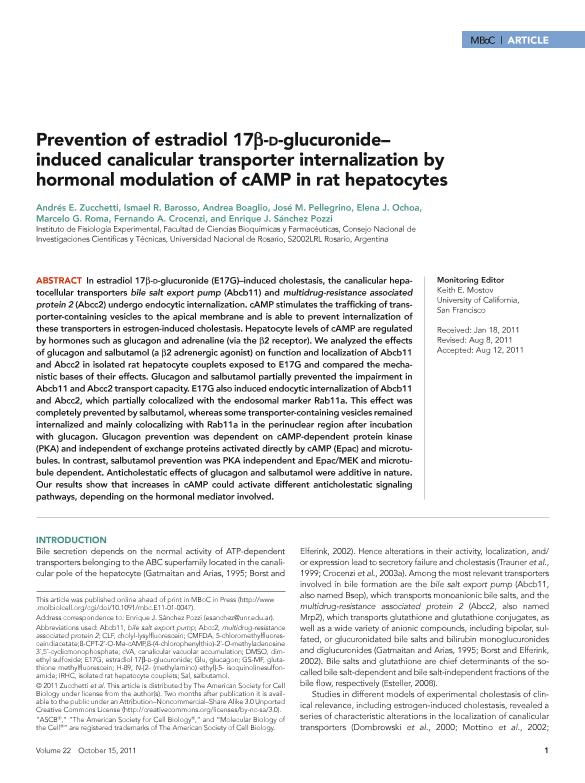Artículo
Prevention of estradiol 17β-d-glucuronide– induced canalicular transporter internalization by hormonal modulation of cAMP in rat hepatocytes
Zucchetti, Andrés Ernesto ; Barosso, Ismael Ricardo
; Barosso, Ismael Ricardo ; Boaglio, Andrea Carolina
; Boaglio, Andrea Carolina ; Pellegrino, Jose Manuel
; Pellegrino, Jose Manuel ; Ochoa, Justina Elena
; Ochoa, Justina Elena ; Roma, Marcelo Gabriel
; Roma, Marcelo Gabriel ; Crocenzi, Fernando Ariel
; Crocenzi, Fernando Ariel ; Sanchez Pozzi, Enrique Juan
; Sanchez Pozzi, Enrique Juan
 ; Barosso, Ismael Ricardo
; Barosso, Ismael Ricardo ; Boaglio, Andrea Carolina
; Boaglio, Andrea Carolina ; Pellegrino, Jose Manuel
; Pellegrino, Jose Manuel ; Ochoa, Justina Elena
; Ochoa, Justina Elena ; Roma, Marcelo Gabriel
; Roma, Marcelo Gabriel ; Crocenzi, Fernando Ariel
; Crocenzi, Fernando Ariel ; Sanchez Pozzi, Enrique Juan
; Sanchez Pozzi, Enrique Juan
Fecha de publicación:
08/2011
Editorial:
American Society for Cell Biology
Revista:
Molecular Biology Of The Cell
e-ISSN:
1939-4586
Idioma:
Inglés
Tipo de recurso:
Artículo publicado
Clasificación temática:
Resumen
In estradiol 17β-d-glucuronide (E17G)–induced cholestasis, the canalicular hepatocellular transporters bile salt export pump (Abcb11) and multidrug-resistance associated protein 2 (Abcc2) undergo endocytic internalization. cAMP stimulates the trafficking of transporter-containing vesicles to the apical membrane and is able to prevent internalization of these transporters in estrogen-induced cholestasis. Hepatocyte levels of cAMP are regulated by hormones such as glucagon and adrenaline (via the β2 receptor). We analyzed the effects of glucagon and salbutamol (a β2 adrenergic agonist) on function and localization of Abcb11 and Abcc2 in isolated rat hepatocyte couplets exposed to E17G and compared the mechanistic bases of their effects. Glucagon and salbutamol partially prevented the impairment in Abcb11 and Abcc2 transport capacity. E17G also induced endocytic internalization of Abcb11 and Abcc2, which partially colocalized with the endosomal marker Rab11a. This effect was completely prevented by salbutamol, whereas some transporter-containing vesicles remained internalized and mainly colocalizing with Rab11a in the perinuclear region after incubation with glucagon. Glucagon prevention was dependent on cAMP-dependent protein kinase (PKA) and independent of exchange proteins activated directly by cAMP (Epac) and microtubules. In contrast, salbutamol prevention was PKA independent and Epac/MEK and microtubule dependent. Anticholestatic effects of glucagon and salbutamol were additive in nature. Our results show that increases in cAMP could activate different anticholestatic signaling pathways, depending on the hormonal mediator involved.
Palabras clave:
Ampc
,
Colestasis
,
Estrógenos
,
Tansportadores Canaliculares
Archivos asociados
Licencia
Identificadores
Colecciones
Articulos(IFISE)
Articulos de INST.DE FISIOLOGIA EXPERIMENTAL (I)
Articulos de INST.DE FISIOLOGIA EXPERIMENTAL (I)
Citación
Zucchetti, Andrés Ernesto; Barosso, Ismael Ricardo; Boaglio, Andrea Carolina; Pellegrino, Jose Manuel; Ochoa, Justina Elena; et al.; Prevention of estradiol 17β-d-glucuronide– induced canalicular transporter internalization by hormonal modulation of cAMP in rat hepatocytes; American Society for Cell Biology; Molecular Biology Of The Cell; 22; 20; 8-2011; 3902-3915
Compartir
Altmétricas



